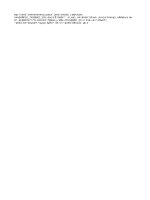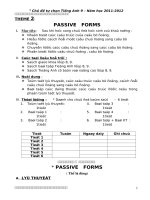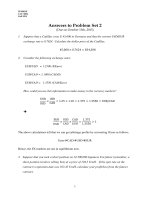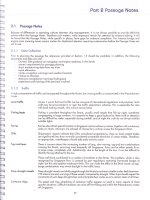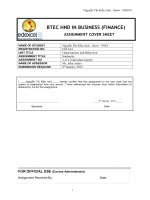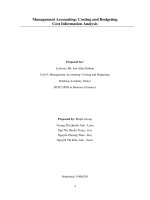1670 assignment 2 (pass)
Bạn đang xem bản rút gọn của tài liệu. Xem và tải ngay bản đầy đủ của tài liệu tại đây (1.97 MB, 81 trang )
BTEC Level 5 HND Diploma in Computing
Unit 30: Application Development
Learner’s name: LAM NGUYEN TRUNG NAM
ID: GCS200222
Class: GCS0905B
Subject ID: 1670
Assessor team name: Đào Vĩnh Khang
Lê Thanh Tùng
Trần Thái Hoà
Assignment due:
Assignment submitted:
lOMoAR cPSD| 22148649
ASSIGNMENT 2 FRONT SHEET
Qualification
BTEC Level 5 HND Diploma in Business
Unit number and title
Unit 30: Application Development
Submission date
8/3/2023
Date Received 1st submission
Re-submission Date
10/3/2023
Date Received 2nd submission
Student Name
ĐÀO VĨNH KHANG
Student ID
GCS200222
Class
GCS0905B
Assessor name
NAM LAM
Student declaration
I certify that the assignment submission is entirely my own work and I fully understand the consequences of plagiarism. I understand that
making a false declaration is a form of malpractice.
Student’s signature
Grading grid
P4
P5
P6
M3
M4
M5
D2
D3
lOMoAR cPSD| 22148649
Summative Feedback:
Grade:
Assessor Signature:
Internal Verifier’s Comments:
Signature & Date:
Resubmission Feedback:
Date:
Assignment Brief 2 (RQF)
Higher National Certificate/Diploma in Computing
Student Name/ID Number:
Unit Number and Title:
Unit 30: Application Development
Academic Year:
2021 – 2022
Unit Assessor:
LAM NGUYEN TRUNG NAM
Assignment Title:
Application development with design diagrams and code
Issue Date:
01 April 2021
Submission Date:
Internal Verifier Name:
Date:
Submission Format:
Format:
•
An individual report document in PDF Submission
•
Students are compulsory to submit the assignment in due date and in a way requested by the Tutor.
•
The form of submission will be a soft copy posted on />
•
Remember to convert the word file into PDF file before the submission on CMS.
Note:
•
The individual Assignment must be your own work, and not copied by or from another student.
•
If you use ideas, quotes or data (such as diagrams) from books, journals or other sources, you must
reference your sources, using the Harvard style.
•
Make sure that you understand and follow the guidelines to avoid plagiarism. Failure to comply this
requirement will result in a failed assignment.
Unit Learning Outcomes:
3
LO3 Work individually and as part of a team to plan and produce a functional business application with support
documentation
LO4 Evaluate the performance of a business application against its Software Design Document and initial
requirements
Assignment Brief and Guidance:
Assignment scenario (continued from Assignment 1) Your team has finished the analysis and design for the system.
Next task is development of the system.
Tasks:
After the presentation about your design (from Assignment 1), you need to create a formal questionnaire
that effectively reviews your business application, problem definition statement, proposed solution and
development strategy. This formal questionnaire should be answered by your colleagues. For any new
insights, ideas or potential improvements to your system you need to evaluate and justify the reasons why
you have chosen to include (or not to include) them as part of this business application. Based on the
feedback of your colleagues, amend the design if needed.
Next task is to develop the business application based on the design, chosen technologies and
methodology. When the application is fully built and tested, you need to review its performance against
the Software Requirement Specificationn, analyze the factors that influence its performance and use them
to undertake a critical review of the design, development and testing stages of your application. Conclude
your review by reflectively discussing your previously identified risks. You should evaluate the strengths
and weaknesses of your business application and fully justify opportunities for improvement and further
development.
To conclude, your report document should include:
•
•
•
Peer review section (questionnaire and answers, your reflection on the feedback)
Development section (how you develop and test the application, what is the result)
Review section (review, analyse and critical evaluate your application)
Your team needs to prepare a demo based on this report for the final demonstration. The
working application must also be demonstrated.
Learning Outcomes and Assessment Criteria (Assignment 2):
Learning Outcome
Pass
Merit
4
Distinction
LO3
P4 Create a formal
questionnaire
that
effectively reviews your
business
application,
problem
definition
statement,
proposed
solution
and
development strategy.
Use this questionnaire as
part of a peer-review and
document any feedback
given.
M3
Interpret
your
peerreview
feedback
and
identify
opportunities
not
previously considered.
P6
Review
the
performance of your
business
application
against the Problem
Definition
Statement
and initial requirements.
M5 Analyse the factors
that
influence
the
performance
of
a
business application and
use them to undertake a
critical review of the
design, development and
testing stages of your
application. Conclude
your
review
by
reflectively discussing
your
previously
identified risks.
M4
Develop
a
functional
business
application based on a
specific
Software
Design Document with
supportive evidence of
using the preferred
P5 Develop a functional tools, techniques and
business
application methodologies.
based on a specified
business problem.
LO4
5
D2 Evaluate any new
insights,
ideas
or
potential improvements
to your system and
justify the reasons why
you have chosen to
include (or not to
include) them as part of
this
business
application.
D3 Critically evaluate
the
strengths
and
weaknesses of your
business application and
fully
justify
opportunities
for
improvement and further
development.
Assignment ..................................... 7
I. Introduction ................................................................................................................................................................. 7
II. Formal questionnaire to review the business application, problem definition statement, proposed ................ 7
solution, and development strategy .............................................................................................................................. 7
III. Application development ....................................................................................................................................... 10
1. Entity Relationship Diagram (ERD) .................................................................................................................. 10
2. Develop a functional business application ......................................................................................................... 12
Develop tools ..................................................................................................................................................... 12
Technique.......................................................................................................................................................... 13
Methodologies ................................................................................................................................................... 15
3. Folder structure of the application .................................................................................................................... 17
4. Code source samples of the application with an explanation .......................................................................... 21
Model ................................................................................................................................................................. 22
Views.................................................................................................................................................................. 26
Controllers ........................................................................................................................................................ 27
Connect database ............................................................................................................................................. 58
5. Final screenshots of the application ................................................................................................................... 59
6. Screenshots of using GitHub or GitLab to manage the source code .............................................................. 65
7. Screenshots of using IIS or Azure for the application deployment................................................................. 66
IV. Application evaluation ........................................................................................................................................... 69
1. Review the performance of the application ....................................................................................................... 69
2. Conclude whether the application adapts all requirements, or it needs to be improved later ..................... 74
3. Analyze the factors that influence the performance of the application .......................................................... 74
4. Evaluate the strengths and weaknesses of the application............................................................................... 74
References ...................................................................................................................................................................... 76
6
Assignment 2
I.
Introduction
I will show the initial directory structure of the program in the application development section.
Next, the next goal of this section will include explanations and source code examples. Third, I will
take a screenshot of the user interface of the finished product. Then I'll demonstrate with
screenshots how to source code using GitHub or GitLab. An image showing how to deploy the
application using IIS or Azure will be shown in the final stage.
In the app review section will first give an assessment of the application's performance. Next, the
application will be evaluated to see if it meets all the requirements or if further improvement is
needed. I will also study the factors that affect the performance of the program. Finally, it evaluates
the original directory structure of the program in the next application development. The next goal
of this section will include explanations and source code examples. Third, I will take a screenshot
of the user interface of the finished product. Then, I will demonstrate with screenshots how to
manage the source code using GitHub or GitLab. An image showing how to deploy the application
using IIS or Azure will be shown in the final stage.
The app review area will first give an assessment of the app's performance. Next, the application will
be evaluated to see if it meets all the requirements or if further improvement is needed. I will also
study the factors that affect the performance of the program. Then evaluate the advantages and
disadvantages of the application.
II. Formal questionnaire to review the business application, problem definition statement,
proposed solution, and development strategy
In this section, the jobs that users can use are based on their account roles. Here is a list of jobs
sorted by role:
- Administrator role: Login, log out, register for Owner account, manage Owner and User accounts,
reset Owner and User accounts, manage category browsing.
- Owner: Log in, log out, manage books(CRUD), request category, manage orders.
-Customers: Login, log out, register, account management, cart management, book preview, book
lookup, see About page.
- Guest: book preview, book lookup, see About page, register.
Questionnaire about the FPT bookstore application:
7
No./Function
Question
1. Log-in
Date
Answer
Date
Whether or not users 20/2/2023
may log in using
accounts from other
websites, such as
Facebook or Google.
Because, as far as I'm
aware, the system
does not currently
have such a function.
Will that feature ever
be upgraded on your
system?
Currently, we are
unable to add
such functionality
to the system, but
we will work to do
so in the future
20/2/2023
If your system has a
feature to save
account
information, do you
use user cookies?
To make logging in
the next time
quicker,
our
system can save
the user's account.
However,
that
doesn't mean we'll
get cookies from
the user. Since we
only save the
account you have
registered for and
do not use your
cookies, you may
use our system
with confidence
20/2/2023
20/2/2023
8
2. Register
Although your
system
has a function for
account
authentication, in my
opinion it is not very
good. Will your
system
ever be
updated to send
authentication
by
email?
21/3/2023
To ensure the
safety of the users
of our system, we
will work to
implement such
function in the
near future.
21/3/2023
3. Edit
information
Can
the
administrator make
changes to the data
that other users have
submitted?
21/3/2023
Any information
regarding other
users may be
changed by our
administrators,
including
the
deletion of their
accounts.
The
user must give us
permission
to
intervene;
otherwise, we do
not have the legal
right to do so.
21/3/2023
4. Searching
Can I find a book by
looking up the
author
or publisher as well
as the book's
description if I'm
looking for one but
don't know the
title?
21/3/2023
It goes without
saying that our
system will utilize
the information
provided by the
user to search the
system
for
pertinent book
goods
21/3/2023
9
5. Role
III.
Are functions like
customer accounts
usable by accounts
with
higher
permissions, and vice
versa, are services
like
customer
accounts usable by
accounts
with
higher
permissions?
22/3/2023
The
22/3/2023
decentralization of
accounts
is
supported by our
technology. Each
account will also
have access to
more
sophisticated
features.
The
account of the
administrator has
the
greatest
permissions,
followed by the
account of the
business
owner
and finally the
account of the
client.
Higherpermissioned
accounts can utilize
the features of
lowerpermissioned
accounts,
while
lowerpermissioned
accounts cannot use
the features of
senior accounts.
Application development
1. Entity Relationship Diagram (ERD)
The diagram below displays entity relationship of the FPTBook web-based application:
10
11
Figure 1 Entity Relationship Diagram (ERD)
2. Develop a functional business application
There are some tools, techniques and methodologies that I use to develop the FPT bookstore
application:
Develop tools
Visual Studio is an Integrated Development Environment(IDE) developed by
Microsoft to develop GUI(Graphical User Interface), console, Web applications, web
apps, mobile apps, cloud, and web services, etc. With the help of this IDE, you can
create managed code as well as native code. It uses the various platforms of
Microsoft software development software like Windows store, Microsoft Silverlight,
and Windows API, etc. It is not a language-specific IDE as you can use this to write
code in C#, C++, VB(Visual Basic), Python, JavaScript, and many more languages. It
provides support for 36 different programming languages. It is available for
Windows as well as for macOS. Evolution of Visual Studio: The first version of
VS(Visual Studio) was released in 1997, named as Visual Studio 97 having version
number 5.0. The latest version of Visual Studio is 15.0 which was released on March
7, 2017. It is also termed as Visual Studio 2017. The supported .Net Framework
Versions in latest Visual Studio is 3.5 to 4.7. Java was supported in old versions of
Visual Studio but in the latest version doesn’t provide any support for Java language.
(geeksforgeeks, 2023)
Figure 2 Visual Studio
Data is a collection of facts and figures and we have humungous data available to
the users via the internet and other sources. To manipulate the data, Structured
Query Language (SQL) in short has been introduced years ago. There are different
versions of SQL available in the market provided by different organizations. In this
article, we shall see the version of SQL provided by Microsoft.
12
Microsoft SQL Server or MS SQL Server for short is the query language
provided for data definition and manipulation.
SQL Server is a Relational Database Management Systems which was
developed and marketed by the Microsoft company.
SQL and SQL servers are built as two layers where the SQL server is on the
top for interacting with the relational databases.
MS SQL Server also has T-SQL or Transact-SQL and the main focus of T-SQL
is to handle the transactions.
As it is a Microsoft’s developed system, it worked only on Microsoft’s
environment until it was made available on Linux platforms in the year 2016.
Figure 3 Microsoft SQL Server
Technique
The term “HTML” stands for Hyper Text Markup Language. It is used to design web
pages using a markup language. HTML is an abbreviation of Hypertext and Markup
language. Hypertext defines the link between the web pages. The markup language
is used to define the text document within the tag which defines the structure of
web pages. HTML 5 is the fifth and current version of HTML. It has improved the
markup available for documents and has introduced application programming
interfaces (API) and Document Object Model (DOM). (geeksforgeeks, 2023)
Figure 4 HTML
13
CSS (Cascading Style Sheets)is used to apply styles to web pages. Cascading Style
Sheets are fondly referred to as CSS. It is used to make web pages presentable. The
reason for using this is to simplify the process of making web pages presentable. It
allows you to apply styles on web pages. More importantly, it enables you to do this
independently of the HTML that makes up each web page. (geeksforgeeks, 2023)
Figure 5 CSS
Bootstrap is a free and open-source tool collection for creating responsive websites and
web applications. It is the most popular HTML, CSS, and JavaScript framework for
developing responsive, mobile-first websites. Nowadays, the websites are perfect for
all browsers (IE, Firefox, and Chrome) and for all sizes of screens (Desktop, Tablets,
Phablets, and Phones). All thanks to Bootstrap developers – Mark Otto and Jacob
Thornton of Twitter, though it was later declared to be an open-source project.
(geeksforgeeks, 2023)
Figure 6 Bootstrap
ASP.NET Core is a free open source, a general-purpose development platform for
developing modern cloud-based software applications on Windows, Linux, and macOS
operating systems. It operates across several platforms and has been revamped to
make .NET fast, scalable, and modern. .NET Core is one of Microsoft’s big contributions
and released under the MIT License. It offers the following features: (geeksforgeeks,
2023)
14
Cross-Platform
Open Source
High Performance
Multiple environments and development mode etc.
Figure 7 ASP.NET Core
Methodologies
The Model-View-Controller (MVC) framework is an architectural/design pattern that
separates an application into three main logical components Model, View, and
Controller. Each architectural component is built to handle specific development
aspects of an application. It isolates the business logic and presentation layer from
each other. It was traditionally used for desktop graphical user interfaces (GUIs).
Nowadays, MVC is one of the most frequently used industry-standard web
development frameworks to create scalable and extensible projects. It is also used
for designing mobile apps. (geeksforgeeks, 2023)
MVC was created by Trygve Reenskaug. The main goal of this design pattern was to
solve the problem of users controlling a large and complex data set by splitting a
large application into specific sections that all have their own purpose.
Features of MVC :
It provides a clear separation of business logic, Ul logic, and input logic.
It offers full control over your HTML and URLs which makes it easy to design web
application architecture.
It is a powerful URL-mapping component using which we can build applications that
have comprehensible and searchable URLs.
It supports Test Driven Development (TDD).
Components of MVC :
15
The MVC framework includes the following 3 components:
Controller
The controller is the component that enables the interconnection between
the views and the model so it acts as an intermediary. The controller doesn’t
have to worry about handling data logic, it just tells the model what to do. It
process all the business logic and incoming requests, manipulate data using
the Model component and interact with the View to render the final output.
Model
The Model component corresponds to all the data-related logic that the user
works with. This can represent either the data that is being transferred
between the View and Controller components or any other business
logicrelated data. It can add or retrieve data from the database. It responds
to the controller’s request because the controller can’t interact with the
database by itself. The model interacts with the database and gives the
required data back to the controller.
View
The View component is used for all the UI logic of the application. It
generates a user interface for the user. Views are created by the data which
is collected by the model component but these data aren’t taken directly but
through the controller. It only interacts with the controller.
Figure 8Model-View-Controller (MVC) framework
16
3. Folder structure of the application
Our website FPT Book project is built on the ASP.NET Core MVC structure paradigm, which
is comprised of Models, Views, and Controllers:
Overall structure of the project: This folder contains the whole code source for the FPTBook
project.
Figure 9 General FPTBook project
As seen in the figure below, application data files are saved in the Areas/Identity folder: The
database's Data folder will house all of the account's data. The output for the registration page
screen, navigation, and account authentication are all included in this Pages folder.
Figure 10 Data folder
17
Figure 11 Areas/Identity folder
The Controllers folder contains directories that describe operations like adding, modifying,
removing, and reading particular model information:
Controllers folder: This folder is used to store the controllers of use cases such as
Admin, Book, Cart, Home, Order, Category
Figure 12 Controllers folder
Constants folders: This directory is used to declare model of Constants
18
Figure 13 Constants folders
Models folders: This folder is used to declare the Category, Book, BookDisplayModel, Order,
CartDetail, ShoppingCart, OrderDetail,ErrorViewModel, Owner.
Figure 14 Models folders
Views folders: This folder is used to save the interfaces of use cases such as Admin, Book, Cart,
Category, Home, Order, Shared
Figure 15 Views folders
In the Views folder, it will contain folders to clearly show the interfaces of each specific model:
Admin folders: The interfaces of the Admin as: Index, RegisterOwner, RequestCategory,
ShowOwner, ShowUser.
Figure 16 Admin folders
19
Book folders: The interfaces of the Book as: Create, Edit, Delete
Figure 17 Book folders
Cart folders: The interfaces of the Cart as : GetUserCart
Figure 18 Cart folders
Category folders: The interfaces of the Category as: Create, Edit, Delete
Figure 19 Category folders
Home folders: The interfaces of the Home as : BookDetail, Index, ShowBook
Figure 20 Home folders
Order folders: The interfaces of the Order as : GetOrder, OrderDetail
Figure 21 Order folders
Shared folder: In this folder, it will save the navigation interface after login as well as the
partial login page of the FPTBook project
20
Figure 22 Shared folder
wwwroot folder: This is the folder to store the source css, fonts, js, libraries as well as images
(in uploads folder) to serve the website.
Figure 23 wwwroot folder
4. Code source samples of the application with an explanation
To get the website up and running using the ASP.NET Core framework, we used the “dotnet
new mvc -o FPTBook_v3” command to create a project called FPTBook_v3. The “dotnet devcerts https –trust” declaration is then used to trust the HTTPS development certificate.
Then we create the necessary models for the project like Category, Book,
BookDisplayModel, Order, CartDetail, ShoppingCart, OrderDetail,ErrorViewModel, Owner.
21

